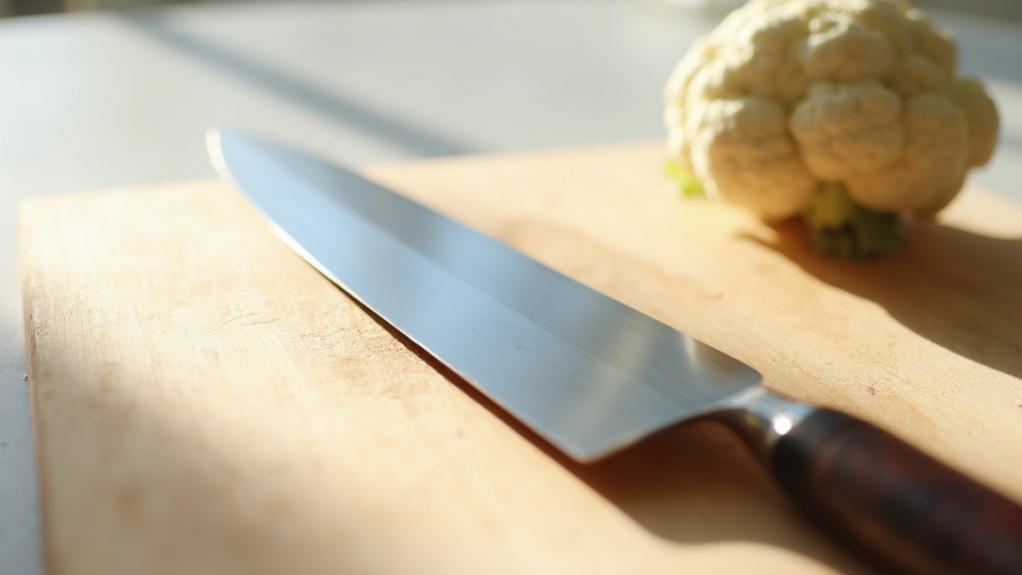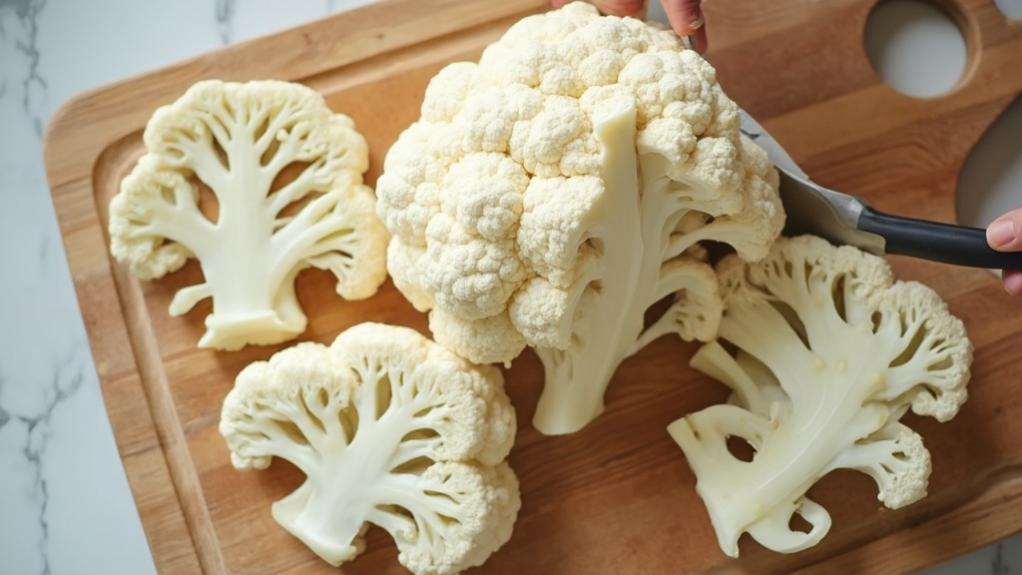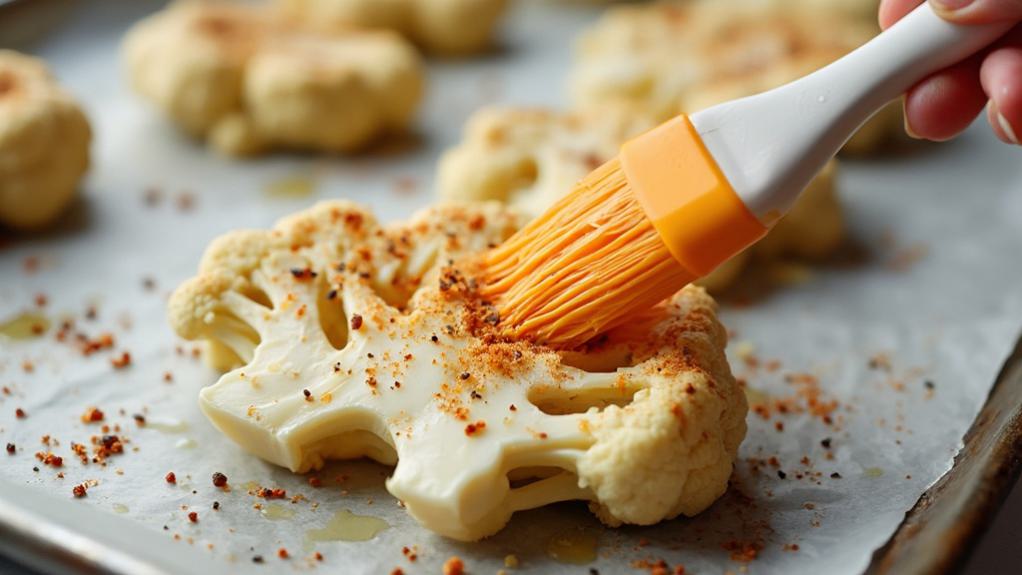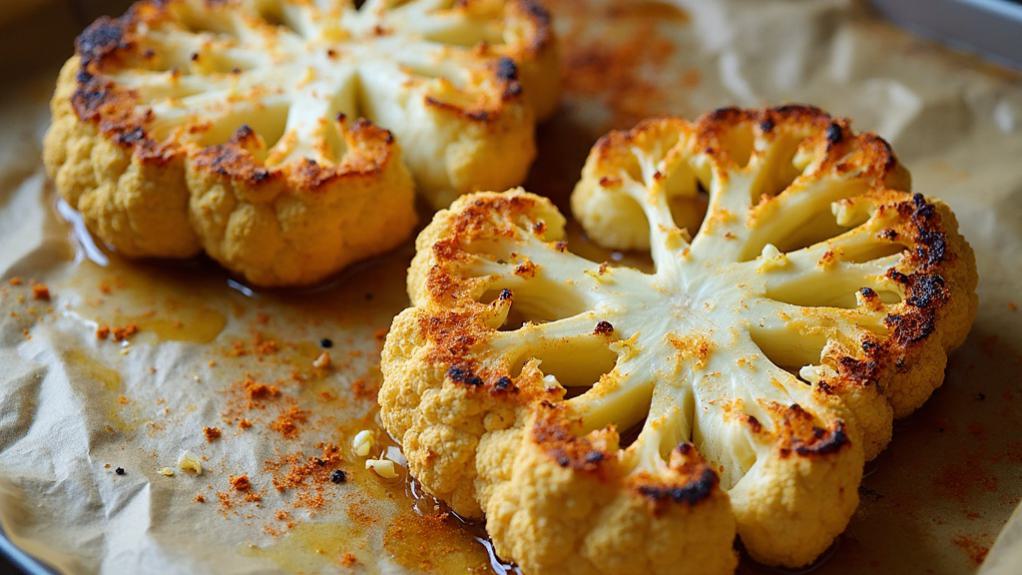At a recent dinner party, I watched as my skeptical meat-loving friend took his first bite of my roasted cauliflower steak and raised his eyebrows in genuine surprise. I’ve mastered this elegant plant-based dish through years of experimentation, discovering that the key lies in achieving the perfect balance of caramelized exterior and tender interior.
The transformation of a humble cruciferous vegetable into a sophisticated centerpiece demonstrates the remarkable versatility of seasonal produce. Let me share my refined approach to creating these golden-brown slabs that have converted even the most dedicated carnivores.
Recipe
Roasted cauliflower steaks offer a hearty and satisfying vegan main course that transforms humble cauliflower into an impressive centerpiece. When sliced into thick portions and roasted until golden, these vegetable steaks develop a caramelized exterior while maintaining a tender, meaty interior that can satisfy even dedicated carnivores.
The secret to perfect cauliflower steaks lies in proper preparation and seasoning. The natural sweetness of cauliflower intensifies through the roasting process, while carefully selected spices create layers of flavor that complement the vegetable’s subtle taste. When paired with the right seasonings and cooked at high heat, cauliflower steaks become a restaurant-worthy dish that’s both nutritious and delicious.
- 1 large head cauliflower
- 3 tablespoons olive oil
- 2 cloves garlic, minced
- 1 teaspoon smoked paprika
- 1 teaspoon ground cumin
- 1/2 teaspoon sea salt
- 1/4 teaspoon black pepper
- 1 tablespoon fresh lemon juice
- 2 tablespoons fresh parsley, chopped
- 1/4 teaspoon red pepper flakes (optional)
Preheat oven to 425°F (220°C). Remove cauliflower leaves and trim stem while keeping the core intact. Stand cauliflower upright and slice through the center into 1-inch thick steaks.
Combine olive oil, minced garlic, paprika, cumin, salt, and pepper in a small bowl. Brush both sides of each cauliflower steak generously with the seasoned oil mixture. Place on a parchment-lined baking sheet and roast for 25-30 minutes, carefully flipping halfway through cooking time.
Once golden brown and tender, drizzle with lemon juice and garnish with chopped parsley before serving.
Select a large, compact head of cauliflower for the best results, as this will yield the most uniform steaks. The outer portions of the cauliflower head may crumble during cutting, but these pieces can be roasted alongside the steaks.
Ensure the cauliflower is completely dry before seasoning, as excess moisture will prevent proper browning. If the steaks start to brown too quickly, cover them loosely with aluminum foil to prevent burning while ensuring they cook through completely.
Step-By-Step Cooking Instructions
You’ll want to begin by gathering your knife and cutting board while mixing your aromatic blend of garlic, paprika, cumin, and olive oil in a small bowl.
Standing your cauliflower upright on the cutting board, carefully slice through the center to create uniform 1-inch thick steaks, keeping the core intact to hold each piece together.
After thoroughly coating both sides of your cauliflower steaks with the seasoned oil mixture, arrange them on a lined baking sheet and roast at 425°F until they’re perfectly golden brown and tender, about 25-30 minutes.
Step 1. Prep Knife and Cutting Board

Along with gathering your ingredients, begin by selecting a sharp chef’s knife and preparing a sturdy cutting board.
You’ll need a knife that’s at least 8 inches long to make clean, precise cuts through the dense cauliflower head. Ensure your knife is properly sharpened, as a dull blade will crush rather than slice through the vegetable’s delicate florets.
Choose a cutting board that won’t slip on your counter surface – wooden or heavy plastic boards work best. If your board tends to move, place a damp kitchen towel underneath to secure it. The board should be large enough to accommodate the entire cauliflower head with ample space around it for safe handling.
Before you begin cutting, thoroughly clean both your knife and cutting board with hot, soapy water and dry completely.
You’ll want to position your cutting board on a flat, stable surface at a comfortable height for precise cutting. Keep a clean kitchen towel nearby to wipe your knife between cuts, ensuring the cleanest possible slices through the cauliflower’s dense core.
Step 2. Prepare Seasoning Mixture

The artful preparation of your seasoning mixture forms the foundation of perfectly roasted cauliflower steaks. In a small mixing bowl, pour three tablespoons of high-quality olive oil, creating the base for your aromatic blend.
Add two cloves of freshly minced garlic, ensuring they’re finely chopped to distribute evenly across the cauliflower’s surface.
Next, introduce the warming spices that’ll transform your dish: one teaspoon of smoked paprika for depth and color, followed by one teaspoon of ground cumin for its earthy undertones.
Measure out half a teaspoon of sea salt and a quarter teaspoon of freshly ground black pepper, adjusting slightly to your taste preferences. Whisk these ingredients together until they’re thoroughly combined, creating a rich, rust-colored marinade.
Don’t add the lemon juice to your mixture just yet – you’ll reserve this final touch for after roasting. Instead, focus on ensuring your spice blend is completely homogeneous, with no clumps of garlic or spices remaining.
Your seasoning mixture should have a smooth, flowing consistency that’ll coat your cauliflower steaks evenly, setting the stage for perfect caramelization in the oven.
Step 3. Cut Cauliflower Into Steaks

With your seasoning mixture ready, proper cutting technique becomes your next focus for creating impressive cauliflower steaks.
Begin by removing the outer leaves and trimming the stem while keeping the core intact, as this structure will hold your steaks together during cooking.
Place the cauliflower head upright on your cutting board, stem side down, and position your knife at the center.
Make your first cut straight through the middle of the head, creating two equal halves. From the cut center of each half, slice outward to create 1-inch thick steaks.
You’ll likely get two to three intact steaks from a large head, depending on its size.
Don’t discard the outer portions that fall away – these loose florets will roast beautifully alongside your steaks.
When cutting, use a sharp chef’s knife and apply steady, even pressure to ensure clean cuts that won’t cause the cauliflower to crumble.
If you notice any dirt or debris between the florets, gently rinse the steaks and thoroughly pat them dry with paper towels, as excess moisture will inhibit proper caramelization during roasting.
Step 4. Brush Seasoning on Steaks

Once your cauliflower steaks are perfectly cut, generously brush each side with your prepared seasoning mixture, ensuring every crevice receives an even coating.
In a small bowl, combine the olive oil, minced garlic, smoked paprika, ground cumin, sea salt, and black pepper, whisking until thoroughly blended. This aromatic blend will infuse your cauliflower with deep, complex flavors while promoting that coveted golden-brown exterior.
Using a pastry brush, apply the seasoning mixture methodically, starting from the center of each steak and working your way outward. Don’t neglect the edges and floret tips, as these areas will develop into deliciously crispy bits during roasting.
You’ll want to be thorough yet gentle with your brushing technique to prevent the steaks from breaking apart. If you notice any dry spots after the initial application, add another light coating of the seasoning mixture.
The oil not only carries the flavors but also helps achieve that perfect caramelization in the oven. Remember to season both sides equally to ensure balanced flavor throughout each steak.
Step 5. Roast Until Golden Brown

After properly coating your cauliflower steaks, place them carefully on a parchment-lined baking sheet, ensuring adequate space between each piece for even heat circulation.
Position the steaks in the center of your preheated 425°F oven, where they’ll receive consistent heat distribution for optimal browning.
Allow the steaks to roast undisturbed for 12-15 minutes until the bottom edges develop a rich, golden-brown color.
Using a wide spatula, gently flip each steak and continue roasting for another 12-15 minutes. You’ll notice the edges becoming crispy while the center remains tender.
If you observe the steaks browning too quickly, loosely cover them with foil to prevent burning while ensuring they cook through completely.
Test for doneness by inserting a knife into the thickest part of the stem – it should glide through with minimal resistance.
The finished steaks should display a deep golden-brown exterior with caramelized edges, while maintaining their structural integrity.
Remove from the oven and let them rest for 2-3 minutes before transferring to serving plates.
The roasted steaks will continue to firm up slightly during this brief resting period.
Why I Love This Dish
I’ve fallen deeply in love with roasted cauliflower steaks for their remarkable ability to transform a humble vegetable into an elegant centerpiece. When I slice through a pristine head of cauliflower and watch it transform under high heat into golden-brown perfection, I’m reminded of culinary alchemy at its finest.
What captivates me most is the textural contrast these steaks achieve – crispy, caramelized edges giving way to tender, meaty centers that satisfy like a traditional protein. The combination of smoked paprika and cumin creates an aromatic depth that elevates the cauliflower’s natural sweetness, while fresh garlic adds a pungent note that mellows beautifully during roasting.
I’m particularly drawn to the dish’s versatility as both a sophisticated main course for vegetarian guests and a striking side dish that holds its own alongside any protein.
The final drizzle of bright lemon juice and scatter of fresh parsley doesn’t merely garnish – it brings the entire dish into perfect balance. When I serve these steaks, they invariably become a conversation piece, proving that vegetable-forward cooking can be both artful and deeply satisfying.

Leave a Reply